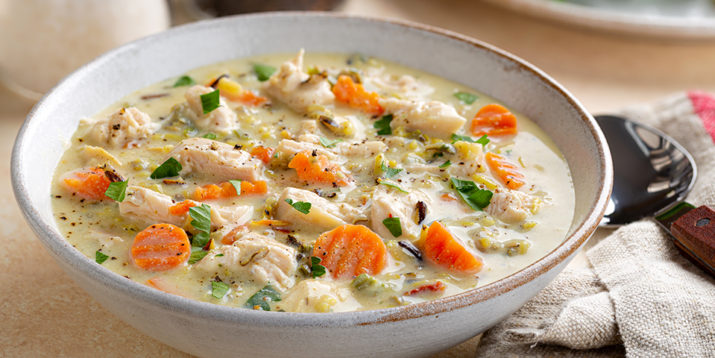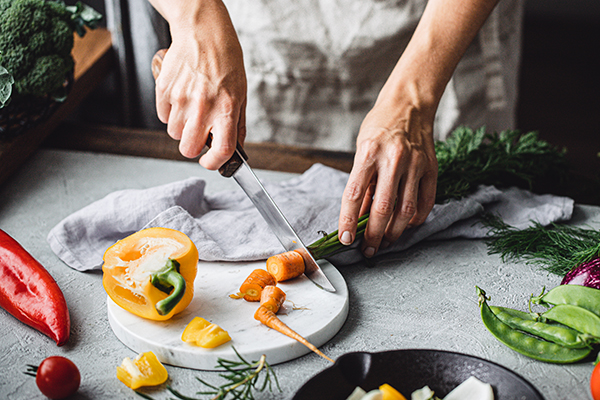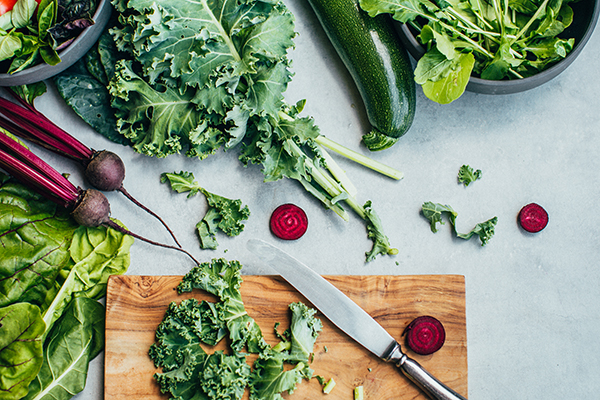How to Make Soup in a Slow Cooker 101

One of the best set-it-and-forget-it meal prep saviors of all the kitchen appliances, the slow cooker has a kitschy vibe now.
Your mom had it right when she dumped ingredients in the slow cooker and let them simmer all day.
There’s no meal more comforting on a cool night than slow cooker soup — but there are a few tips and tricks to getting it just right.
Low and slow is the idea. It’s in the name of the kitchen tool, after all. Learn how to bud nuanced flavors in a super-easy way with a slow cooker.
Just in time for soup season, here’s a step-by-step guide to making the best slow cooker soup.
How to Make a Healthy Slow Cooker Soup

“Soup can be made into a hearty, balanced meal that is sure to satisfy,” says Krista Maguire, R.D.
“In addition to loads of veggies, add a protein like chicken or beans and a starchy veggie like sweet potato or whole grains like quinoa,” she adds.
Add dairy-free creaminess and thickness to a healthy slow cooker soup by pureeing beans, potatoes, or a slice of day-old bread with broth or full-fat coconut milk.
You can also combine water and nutritional yeast with pureed-until-smooth cashews.
Steer clear of granulated stock powders or cubes — many contain monosodium glutamate, artificial colors, and hydrogenated oils.
Opt for low-sodium, all-natural stocks or bone broths.
Ready to get cooking? Follow these steps for slow cooker soup success!
1. Brown meats first to deepen flavor
Yes, it’s an extra step, but this adds tons of flavor. Sear all sides of the meat before you add it to the slow cooker, then let it simmer.
2. Use less liquid
Revamping a stovetop soup recipe? Use less liquid, since it evaporates less when simmering in a slow cooker, thanks to the tight-fitting lid.
Cover the ingredients with broth, water, or your liquid of choice by a scant ¼-inch.
3. Bump up the plants

A little bit of meat can go a long way to add flavor and protein. Bulk up the soup with added veggies in every color. (You can also add legumes and whole grains.)
Soup is a great way to get more vegetables into your day.
4. Trim most visible fat from meat
There’s nowhere for the fat to go in a slow cooker (and it can’t be easily drained off like it can on the stove), so cut it off before cooking.
Otherwise, you’ll end up with pools of fat in your soup — not good eats.
5. Skip the oil
Unlike stovetop soup methods, you don’t need to add oil to the slow cooker pot. Nothing will stick!
6. Don’t overfill the pot
Three-quarters full is the maximum, but two-thirds is ideal. If you fill the pot too high, it could leak or cook inconsistently.
7. Thicken in two steps
The liquid in your slow cooker doesn’t get hot enough to reduce or thicken, so if you don’t want a thin soup, you’ll need to add a thickening agent.
Use any type of flour or a starch like tapioca or arrowroot.
Combine one tablespoon of flour or starch per one cup of liquid, whisk until smooth, then stir into the soup and simmer.
8. Use cheaper cuts of meat
Tough, leaner cuts love the long, slow, gentle simmering of a slow cooker.
It breaks down any sinewy bits, transforming them into melt-in-your-mouth tender savoriness.
Don’t splurge on filets or lobster tails for a slow-simmered soup.
9. Cook low and slow
Cook soups on low to develop the most flavor. If you’re pressed for time, you can cook them on a higher setting but make sure to halve the cooking time.
10. Cut veggies roughly the same size
Cutting each vegetable uniformly will help them cook evenly. To prevent vegetables from getting too mushy, avoid cooking them for many hours on high heat.
Add softer or quicker-cooking veggies like zucchini and summer squash in the last hour.
11. Let the slow cooker do its thing
Every time you open the lid, you release heat, so resist the urge to peek. Set it up and walk away.
This cooking method is meant to save you time, so let it do the work for you!
How to Layer Slow Cooker Soup Ingredients
Place the ingredients that require the longest cooking time at the bottom of the pot, closest to the heat source.
Here’s a basic guide if you’re creating your own slow cooker soup recipes.
Add these ingredients at the beginning:
- Uncooked vegetables: Add root vegetables (potatoes, turnips, carrots) on the bottom, followed by onions, shallots, or leeks.
- Uncooked, rinsed, or soaked beans: Dried beans take 3–4 hours to cook on high, and 6–8 hours to cook on low in the slow cooker, says Kalyn Denny, a food blogger at Kalyn’s Kitchen and home cook.
- Broth, stock, water, coconut milk: The liquid is what makes things a soup, after all.
- Uncooked meats: If you have time to brown meat, great. Exceptions include chicken or turkey breast, fish, and shellfish.
- Cheese rinds: An old Italian cook’s tip, add Parmesan or Romano cheese rinds to impart a nutty, salty flavor. Discard any remaining rind before serving.
Add these in the last 15–45 minutes of cooking:
- Meats and seafood that don’t take long to cook, such as chicken breast (sliced or cut), fish, or shellfish. Add chicken breast in the last 25–30 minutes of cooking.
- Dried lentils only take about 30–40 minutes of simmering to cook through, notes Nagi Maehashi, the cook and creator of RecipeTin Eats. Use red, yellow, brown, and green lentils but not Puy lentils, as they don’t soften as well as the others, she says.
- Fresh delicate herbs like basil, mint, or tarragon: Ladle the soup into serving bowls and sprinkle with torn fresh herbs for a bright pop of color and flavor.
- Hearty fresh herbs like rosemary, oregano, parsley, celery leaves, beet greens, etc.: Add during the last 15–20 minutes, particularly with rosemary, which can get bitter when cooked for too long, says Emma Christensen, a food writer and graduate of the Cambridge School for Culinary Arts.
- Thickening agents: Add when the soup has finished cooking. Stir it in, replace the lid, and warm for a few minutes, then serve.
- Already-cooked ingredients: Add cooked grains in the last 15–20 minutes of cooking. Stir in leftovers like cooked pasta in the last 10 minutes.
- Quick-cooking ingredients: Add dried pasta, quinoa, and starchy or frozen veggies during the last 15 minutes.
- Dairy: Stir in reduced-fat Greek yogurt or reduced-fat sour cream in the last 5 minutes to avoid curdling.
Looking for more expert nutrition information? Head over to BODNutrition.com and learn how to eat healthy for the long-term with the help of our two nutrition programs, 2B Mindset and Portion Fix.
